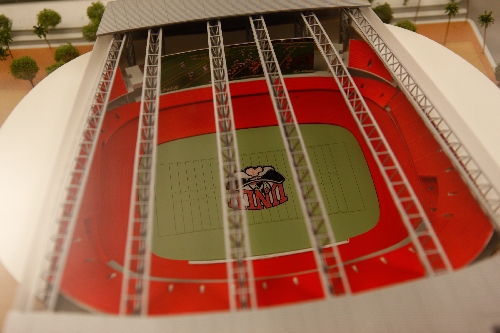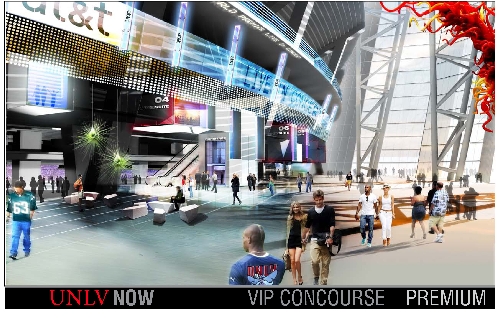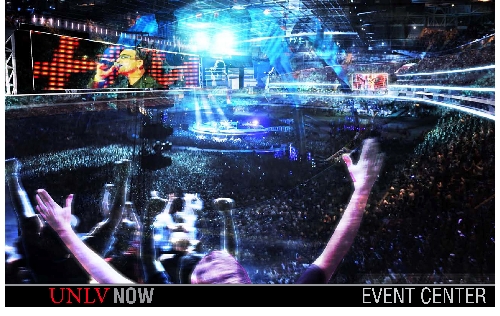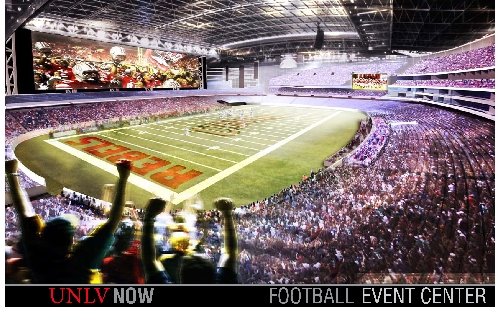Proposed UNLV domed stadium has super amenities
A half-dozen "super suites" that will house 300 guests and sell for more than $1 million a year.
Theater-style seating.
And the world's biggest indoor stadium video screen - longer than a football field.
Those were just three of the highlights of a proposed 60,000-seat "Mega-Event Center" on the UNLV campus unveiled Friday to the Board of Regents.
Craig Cavileer, president of the Silverton and pointman for Majestic Realty, the development company partnering with UNLV on the domed stadium project, unveiled images of the venue in hopes of drawing the regents' support.
The stadium would be part of an overall campus redevelopment project dubbed UNLV Now, which also includes 2,000 to 3,000 student housing units and 300,000 to 400,000 square-feet of retail space to be built by Majestic. Cavileer said the retail space will be similar to the Town Square outdoor mall in Las Vegas. A consultant from the University of Michigan who conducted a stadium economic impact study estimated the cost of the stadium project at between $800 million and $900 million.
While the venue would serve as the home of the UNLV football team, Cavileer stressed that the building is much more than a conventional football stadium.
"This is not a stadium. It's an events center. We don't need a resident team," Cavileer told the regents and an audience at the UNLV student union.
Veteran sports architect Dan Meis of Venice, Calif., designed the venue for Majestic.
"One of the things we explored was the video board's importance to the event," Meis said Friday from New York.
The six "super suites" are another unique feature because each would house 250 to 300 guests. Most conventional football stadium suites house 20 to 25 guests and sell for $200,000-$500,000 a year. But Cavileer said the super suites would easily go for seven figures a year. He envisioned major casinos or corporations buying the super suites.
Pat Christenson, president of Las Vegas Events, outlined an array of non-football events that could use the venue. His example: electronic music festivals, UFC Fight Week, Wrestlemania, soccer, rugby, the college basketball Final Four games and touring concerts.
Potential football events for the stadium include an NFL Pro Bowl, an NFL preseason game, a new college bowl game and a regular-season game between two powerhouse college teams.
While the venue's bells and whistles, such as the gigantic video board embedded in the stadium and the spacious super suites, impressed the regents, several board members wanted Don Snyder, dean of the College of Hotel Administration at UNLV and the university's point man on the project, to return with an analysis of the project's upfront costs, revenue streams, operating expenses and return on investment for the UNLV campus.
UNLV President Neal Smatresk said the stadium would be a revenue-generator for the campus, but he declined to specify the amount.
Much of the proposal's numbers will be discussed at a Board of Regents workshop on Feb. 22. The key unknowns: the cost to build the stadium, relocate displaced athletic fields and provide infrastructure; the public's share of the project's construction cost; and the split of the revenues from money-makers such as naming rights and suite sales.
The Board of Regents is expected to vote on the events center proposal at its Feb. 28 meeting.
To fund the public's share of the stadium costs, Snyder is counting on proposed legislation that would create a tax increment financing district on the UNLV campus that would generate tax revenues from retail sales.
Snyder told the regents that representatives have contacted state lawmakers about the proposed legislation. The Legislature convenes Feb. 4.
Contact reporter Alan Snel at asnel@reviewjournal.com or 702-387-5273.





















